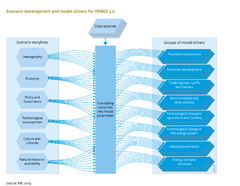Drivers/Scenario drivers: Difference between revisions
< Drivers
Jump to navigation
Jump to search
No edit summary |
No edit summary |
||
| Line 20: | Line 20: | ||
Population data are used in energy and agricultural economics modelling, and in other IMAGE modules, such as [[Water|water stress]], [[Nutrient balances|nutrients]], [[Flood risks|flood risks]] and [[Human development|human health]]. | Population data are used in energy and agricultural economics modelling, and in other IMAGE modules, such as [[Water|water stress]], [[Nutrient balances|nutrients]], [[Flood risks|flood risks]] and [[Human development|human health]]. | ||
===Policy and governance=== | |||
Scenarios may differ considerably with regard to assumptions on implicit or explicit policies that reflect alternative future developments in human and natural systems, and assumptions on the evolution of governance structures and institutional settings. While policy thinking may vary, a key scenario split in IMAGE is more focus on the shorter term and/or on material wealth, or focus on longer term sustainability concerns. Based on this, inter-regional and/or inter-generational equity may be awarded more or less weight as an underlying future trend. As mentioned under culture and lifestyle, such assumed directions in overall policy have the potential to influence almost all relevant scenarios and model drivers. | |||
In addition to alternative policy directions, other important factors are developments in governance structures and institutions in different world regions, or in groups of regions sharing certain characteristics. For instance, this may concern high-income industrialised countries, medium income emerging economies, or low-income developing countries. | |||
Other elements may also make some policy measures and instruments more or less plausible. For example, a concerted and jointly implemented global climate mitigation strategy is less conceivable in a world with diverging regions primarily pre-occupied with short-term domestic interests and weak intergovernmental bodies. | |||
===Technological development=== | |||
At scenario level, the assumed technical progress is the key driver of economic growth. Given an effective labour force, the increase in labour productivity delineates the potential for economic growth. In scenarios, it is generally assumed that the degree of technical progress is reflected in all areas where technology plays a role. Thus, an assumed rapid growth in technology leading to high economic growth implies that technological options in specific sectors (e.g., energy and agriculture) will also develop relatively quickly. However, the directions of technological change may differ within and across sectors. For example, renewable energy technologies may improve more rapidly than fossil fuel based technology. Thus, this is an uncertain factor. | |||
In the energy sector (see [[Energy supply and demand]]), technology improvements over time are largely governed by an endogenous mechanism that links technology cost to the cumulative capacity, learning by doing. Technological factors in agriculture are estimated exogenously, based on historical data and projections from the literature on crop and livestock productivity, efficiency in water and fertiliser use, and performance of irrigation systems. | |||
===Culture and lifestyle === | |||
For comparable levels of affluence, observed consumption behaviour differs greatly between countries and regions, and to a lesser extent within countries. The modal split for passenger transport by walking, bicycle, car, bus, train, boat and aircraft depends on income, but also on engrained traditions and habits of social groups. Food preferences depend on availability and affordability, and also greatly on cultural factors, such as religion (e.g., no pork for Jewish and Islamic households, and no beef or no meat at all for Hindus), and on tradition, values and health concerns. In addition, behaviour may be influenced by concerns about environmental degradation, animal welfare, inter-regional and inter-generational equity, and other issues according to dominant social norms and values. | |||
Consumer preferences and lifestyles may change over time, as may norms and values. The direction and rates of change can be inferred from the underlying scenario storyline. Policies may be put in place to enable, encourage or even induce change, given sufficient public support. | |||
===Natural resource availability=== | |||
The term, ultimate natural resources, refers to the amount of resources theoretically available if not affected by human activity. For non-renewable resources, such as coal and iron ore, this concerns the accumulated amount before human extraction began. For renewable resources, such as solar energy, it represents the solar radiation intercepted on Earth in a given time period. As the ultimate quantities of these natural resources cannot be changed by humans, they cannot be considered as scenario drivers in IMAGE. Similarly, the global land area is fixed, except for relatively limited reclaimed areas in shallow coastal waters and natural processes by which land area is increased (e.g., volcanic islands) and land area is reduced (e.g., coastal erosion). | |||
The quantity of a resource available in the future depends on exogenous assumptions for the scenarios. The estimated quantities depend on the assumed future technology capabilities, policies and human preferences. Higher estimates of non-conventional fossil fuels and nuclear fuel reserves are associated with technology optimism, for example, estimates of natural gas reserves depend on whether the extraction of deep seabed methane is considered a viable option. Nature conservation and other issues may limit the potential for natural land conversion for agriculture, but may also impose limits on hydroelectricity generation. | |||
In IMAGE 3.0, renewable and non-renewable energy resources are modelled by volume and price, see Component [[Energy supply]]. Similarly, the potential land for agriculture ranked according to suitability and is subject to nature conservation policies, limits future land conversion, see Component [[Agricultural systems]]. | |||
Revision as of 13:51, 9 May 2014
Parts of Drivers/Scenario drivers
| Projects/Applications |
| Models/Databases |
| Relevant overviews |
| Key publications |
| References |
